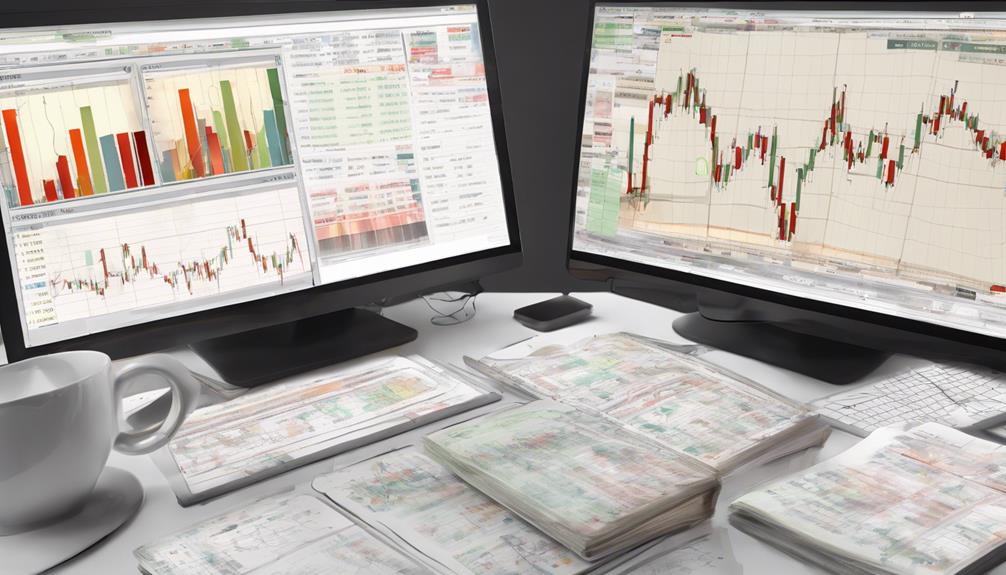If you're new to forex trading, learn the fundamentals of the $6.6 trillion market. Trade currency pairs, understand how exchange rates fluctuate, and know the 24/5 market operation. Discover trading strategies like trend following and breakout to manage risks and reap rewards. Explore sessions overlapping for enhanced liquidity and best trade times. Be aware of risks like market manipulation and leverage amplification. Start with demo accounts, track trades, and stick to your plan for a successful trading journey. Mastering forex basics is essential for your success in the complex global market.
Key Takeaways
- Forex trading involves trading currency pairs like USD/EUR.
- Market operates 24/5 with high liquidity and accessibility.
- Risks include volatility, leverage, and market manipulation.
- Strategies include trend-following, breakout, and risk management.
- Practice with demo accounts, maintain a trading plan, and use stop-loss orders.
Forex Market Basics

Curious about how the forex market operates and why it's so vital?
The forex market, a global marketplace for currency trading, witnesses daily trading volumes exceeding $6.6 trillion, making it the biggest financial market worldwide. This market involves trading currency pairs like USD/EUR or USD/JPY, where exchange rates fluctuate due to the diverse range of participants, including central banks, financial institutions, corporations, hedge funds, and individual traders.
Operating 24 hours a day, five days a week, the forex market allows for continuous trading opportunities across different time zones.
Market participants engage in speculative trading, influencing exchange rates that impact global economies. Retail traders contribute a notable 3-5% of the total trading volume, showcasing the accessibility of forex trading to individual investors. Understanding the basics of the forex market, such as currency pairs, exchange rates, and the involvement of various market players, is essential for maneuvering this dynamic and liquid financial arena.
Trading Strategies

Exploring different trading strategies in forex can greatly enhance your chances of success in maneuvering this dynamic financial market. Forex trading strategies encompass various approaches such as trend following, breakout strategies, carry trades, and scalping strategies. To navigate the forex market successfully, it's vital to establish a robust risk management framework, create a trading plan, and define clear entry and exit plans. By incorporating technical analysis, economic indicators, and staying informed about geopolitical events, you can make well-informed trading decisions. Implementing effective forex trading strategies also involves adapting to changing market conditions and continuously refining your approach. It’s important to stay disciplined and avoid emotional decision-making, as well as staying up-to-date with the latest market trends and developments. By constantly evaluating and adjusting your trading strategies, you can increase your ability to capitalize on profitable opportunities and minimize potential risks in the forex market.
Implementing a trend-following strategy involves identifying and riding market trends, while breakout strategies focus on trading assets when they breach key levels. Carry trades capitalize on interest rate differentials between currencies, aiming to profit from the interest rate spread. Scalping strategies involve making quick, short-term trades to exploit small price movements.
Developing a structured trading plan with specific goals, risk management guidelines, and chosen trading strategies is fundamental for consistent success in the forex market. By starting with small investments and gradually increasing position sizes as you gain experience, you can further optimize your trading approach to align with your risk tolerance and financial objectives.
Forex Market Operations

To effectively navigate the forex market, understanding the operational dynamics of forex trading is key. The forex market operates 24 hours a day, five days a week, with trading sessions moving between major financial centers such as Tokyo, London, and New York. These major trading sessions overlap, providing traders with increased trading opportunities and liquidity. Knowing the optimal times and days to engage in forex trading can help traders make the most of market movements. Each trading session has its unique characteristics, with the most active trading times aligning with the overlapping hours of major financial hubs. The continuous operation of the forex market enables traders to participate in trading activities at any point during the week, offering flexibility and accessibility for global participants.
| Keywords | Description |
|---|---|
| Trading Sessions | Shift across major financial centers like Tokyo, London, and New York. |
| Liquidity | Increased during overlapping trading sessions, providing trading opportunities. |
| Global Participants | Engage in trading activities at any time due to continuous market operation. |
| Market Movements | Optimizing trading times to capitalize on market movements. |
Risk and Rewards

Understanding the risks and rewards associated with forex trading is necessary for aspiring traders to make informed decisions in the market.
When delving into the world of forex trading, consider the following:
- Risks: Be cautious of the high volatility inherent in the forex market, as well as the potential for market manipulation and fraud.
- Leverage: Comprehend that while leverage can amplify profits, it also magnifies losses, emphasizing the need for effective risk management strategies.
- Rewards: Despite the risks, forex trading offers benefits such as high liquidity, low transaction costs, leverage for controlling large positions, and diverse trading options.
It's vital to acknowledge that losses in forex trading can surpass your initial investment. Thus, implementing risk management practices like setting stop-loss orders and proper position sizing is essential for navigating the landscape of forex trading effectively.
Trading Tips

Consider using demo accounts to practice trading strategies and get acquainted with the platform before risking real money. This allows you to familiarize yourself with the dynamics of Forex markets without the pressure of potential financial losses.
Keeping a trading journal is pivotal as it helps you track your trades, evaluate your performance, and pinpoint areas for enhancement in your trading strategy. Remember to adhere to your trading plan diligently to steer clear of emotional decision-making and maintain consistency in your approach to Forex trades.
Implementing stop-loss orders is essential to mitigate risks by setting predefined levels to limit potential losses and safeguard your trading capital from adverse market movements. Prioritize risk management by appropriately sizing your positions and diversifying your trades to minimize overall risk exposure in the currency market.
Frequently Asked Questions
How to Learn Forex Trading Step by Step for Beginners?
Start by understanding basic concepts like currency pairs and pips. Immerse yourself in various trading strategies, analyze charts for trends, and practice with a demo account. Develop a solid trading plan with clear goals and risk management.
Can I Learn Forex on My Own?
Yes, you can learn forex on your own. Utilize online resources, tutorials, and demo accounts offered by brokers. Practice with virtual money, explore educational tools, and engage with trading communities to enhance your skills independently.
What Is the Simplest Way to Explain Forex Trading?
The simplest way to explain forex trading is by understanding it as the buying and selling of currency pairs to profit from price movements. It's like a global marketplace where currencies dance 24/5.
What Is the Best Currency to Trade in Forex as a Beginner?
Focus on major currency pairs like EUR/USD, USD/JPY, GBP/USD, and USD/CHF as a beginner. They offer high liquidity, stability, and ample trading opportunities. Avoid exotic pairs initially. Stick to majors for better market visibility.
Conclusion
Now that you've learned the basics of forex trading, remember to stay informed, be patient, and practice your strategies.
The forex market is like a vast ocean, full of opportunities and risks. Immerse yourself, navigate carefully, and let your profits ride the waves of success.
Happy trading!









